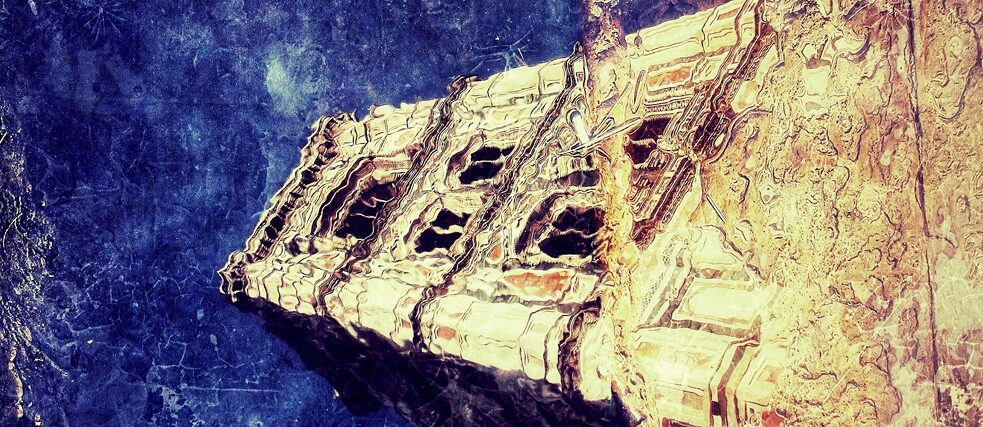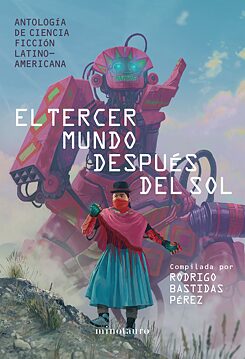Science Fiction Literature
“There Cannot Be a Future If We Have Not Previously Dreamed It”

Camilo Jiménez Santofimio chats with the editor and literary expert Bastidas Pérez about the science fiction world in Latin America.
By Camilo Jiménez
 Rodrigo Bastidas Pérez
| © Rodrigo Bastidas Pérez
Rodrigo Bastidas Pérez
| © Rodrigo Bastidas Pérez
Rodrigo Bastidas Pérez holds a PhD in Literature from the University of the Andes, Colombia. In the beginning of 2021, he published El tercer mundo después del sol (The Third World After the Sun), a collection of 14 Latin American science fiction short stories. In it, authors from the continent connect technological observations, indigenous imaginaries, postcolonial discourses, and fantasy to dream of possible worlds. Editor Camilo Jiménez Santofimio spoke with Bastidas Pérez about the history and themes of science fiction literature in Latin America and why the genre is much closer to reality than is sometimes believed.
What is the connection between science fiction and dreams?
Science fiction is not based on a realist representation, but rather on a dream. The premise is that there cannot be a future if we have not previously dreamed it. So, the future depends on the dream, which functions in the space of desire. The Welsh critic Raymond Williams approaches science fiction from the idea of utopia. To dream utopias, he says, allows us to move closer to them. That is important in science fiction, since beneath every genre lies a utopian construction, which is the seed of ideas having to do with society, economy, urban planning, et cetera.
How is that represented in Latin American science fiction?
Anxiety has been a central theme, which, in Latin America, impacts the way we think about technology and our desire to control it. This technological anxiety creates discourses and narratives and leads us to the world of dreams because, in texts that produce science fiction, dreams are realized. Fredric Jameson, a critic from the United States, defines science fiction as a literature of desire. There, anxiety and technological desire are transformed into something real through the literary work.
When is the first time that this connection between technological desire and literature appears in Latin America?
One could mention many turn-of-the-century authors who were amazed by the machines created in their time. In the short story “La verónica” (1896) by the Nicaraguan poet Ruben Darío, a priest takes a photo of a communion wafer in order to capture the image of Christ. In “El vampiro” (“The Vampire,” 1927), Uruguyan Horacio Quiroga makes a dream reality through cinematography: His character revives his dead wife with the help of celluloid. The fascination with these new machines gives life to dreamed worlds in de Leopoldo Lugones’s “Las fuerzas extrañas” (“Strange Forces,” 1906) in Argentina and in Mexico with Amado Nervo, to name a few.
For me, one of the most important works of Latin American science fiction is El Eternauta (The Ethernaut, 1957-1959), by Argentine Héctor Germán Oesterheld, which imagined, at the height of the dictatorship, an out-and-out extraterrestrial invasion that only the union of citizens in opposition to those in power could contain. The benefit of science fiction in this case is that, since it has almost always been considered young adult literature, it was not read as political literature, but only as escapist literature. These unrealistic worlds thus ended up enabling more discussion about reality.
Is this still the case today?
Yes, contemporary science fiction is not only a literature of dream worlds; it is also speculative. This is observable in Cuba with Daína Chaviano and Erick Mota whose books critique political space through symbolic solutions. In Fábulas de una abuela extraterrestre (Fables of an Extraterrestrial Grandmother, 2018), Chaviano explores interplanetary travel centered on Havana, and in Habana underguater (2010), Mota presents a version of the internet created through Yoruba gods. There is also the Argentine Liliana Bodoc who has gone back to the cosmogonies of indigenous peoples to supply arms to epic worlds. Her trilogy La saga de los confines (Saga of the Borderlands, 2000-2004) is Latin American fantasy, but we can also see it as science fiction, given that form is not only a discourse, but also another way of desiring the world. There, indigenous beliefs are not mythological, but are different ways of understanding the world, different forms of knowledge.
What other tendencies do you see in contemporary Latin American science fiction?
I see three. One is the development of the New Weird genre, “El nuevo raro.” It is a slight deviation from the science fiction that has been established in our region. It is based on the notion that not everything is explainable by science or by a logical structure and imagines a future that is unknown, indeterminate, and hair-raising. A ritual such as ingesting ayahuasca (a psychedelic) occurs without any logical explanation that could justify it fully. The New Weird borders on horror, the great genre where things are not explained, and opts for a space of uncertainty. For example, Distancia de rescate (Fever Dream, 2014), by Samantha Schweblin, could easily belong to the New Weird. Other examples are the work of Mexican Alberto Chimal and Uruguyan Ramiro Sanchiz.
 Cover of El Tercer Mundo después del sol (The Third World after the Sun), edited by Rodrigo Bastidas Pérez, Ediciones Minotauro, 2021.
| © Rodrigo Bastidas Pérez
What are the other two tendencies?
Cover of El Tercer Mundo después del sol (The Third World after the Sun), edited by Rodrigo Bastidas Pérez, Ediciones Minotauro, 2021.
| © Rodrigo Bastidas Pérez
What are the other two tendencies?
Close to the fluid nature of the New Weird is the perspective on queerness, increasingly a topic of discussion. My reference here is to the tendency to make books that combine terror, science fiction, and fantasy. Teresa P. Mira de Echevarría from Argentina has carried out extensive analysis on queer spaces in science fiction. Lastly, I want to mention “cli-fi,” or climate science fiction, which points to the broad questions in Latin America around the Anthropocene and the climate crisis. This affects us a great deal because we see the destruction firsthand. Aún el agua (Still the Water, 2019) by Juan Álvarez is a good example.
How would you describe the current geography of Latin American science fiction?
I would draw from the authors who are reclaiming indigenous knowledge, finding spaces to think and recover futures in those roots. The Caribbean comes very close to Afrofuturism, which deals with imagining the future through African ideological structures. This is the case of Cuban Maielis González Fernández and Dominican Rita Indiana whose book La mucama de Omicunlé (Tentacle, 2015) is entirely based on the beliefs of the gods. In the Andes region, there is a pursuit of knowledge through myths, in the works of Ecuadorian Juan Luis Jacome and Peruvian Daniel Salvo, for instance. In the Southern Cone, we see these perspectives as well. Within the context of Mapuche indigenous culture in Chile, Jorge Varadilla, a current constitutionalist, does this. For example, through his work on cyber-shamanism, he converts a shaman into a hacker who hacks nature.
What authors would you recommend reading today?
Among the Colombians, Luis Carlos Barragán is the one who does the most with science fiction. Karen Andrea Reyes has also written an excellent novel, Zen’nō. From Mexico, I recommend Andrea Chápela and, from Cuba, Elaine Vilar, particularly her novel La tiranía de las moscas (The Tyranny of the Flies). Lastly, in Argentina there is a writer named Kike Ferrari whose stuff is amazing. He is an avid reader and an award-winning science fiction author. When they went to see who he was, they found out that he was sweeping subway cars and was part of the workers’ union. They realized that he was a genius, and although he won the prize, he kept on working there. He does not have a classical vision; reading him is like a re-reading of contemporary authors. I highly recommend him.